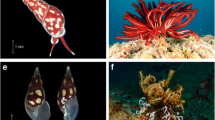Abstract
A Petri dish bioassay previously used to examine food preferences in planorbid snails was used to study intraspecific and interspecific chemoattraction inBiomphalaria glabrata (albino strain, M-line) andHelisoma trivolvis (Colorado strain) snails.B. glabrata snails showed significant intraspecific chemoattraction in the absence of visual cues and snail thigmotaxis.H. trivolvis snails also showed significant intraspecific chemoattraction. Interspecific chemoattraction between these species occurred in the bioassay, suggesting that the chemoattractants were not species specific. Artificial spring water conditioned by aqueous excretory-secretory products (snail-conditioned water) ofB. glabrata elicited significant intraspecific chemoattraction. However, lipophilic excretory-secretory products ofB. glabrata elicited significant chemorepulsion. Repellant factors in the lipophilic fraction were not characterized.
Similar content being viewed by others
References
Cohen, L.M., Neimark, H., andEveland, L.K. 1980.Schistosoma mansoni: Response of cercariae to a thermal gradient.J. Parasitol. 66:362–364.
Dinter, I. 1974. Pheromonal behavior in the marine snailLittorina littorea Linnaeus.Veliger 17:37–39.
Duncan, M., Fried, B., andSherma, J. 1987. Lipids in fed and starvedBiomphalaria glabrata (Gastropoda).Comp. Biochem. Physiol. 86A:663–685.
Fried, B., Tancer, R.B., andFleming, S.J. 1980. In vitro pairing ofEchinostoma revolutum (Trematoda) metacercariae and adults, and characterization of worm products involved in chemoattraction.J. Parasitol. 66:1014–1018.
Haseeb, M.A., andFried, B. 1988. Chemical communication in helminths.Adv. Parasitol. 27:169–207.
Marcopoulos, A., andFried, B. 1993. Chemoattraction ofBiomphalaria glabrata (Gastropoda: Planorbidae) to lipid standards and lipophilic factors in leaf lettuce and Tetramin.J. Chem. Ecol. 19:2593–2598.
Masterson, C., andFried, B. 1992. Chemoattraction and dietary preferences ofBiomphalaria glabrata (Gastropoda: Planorbidae) for leaf lettuce, Tetramin and hen's egg yolk.Comp. Biochem. Physiol. 103A:597–599.
Pearce, J.B., andThorson, G. 1967. The feeding and reproductive biology of the red whelk,Neptunea antique (Linnaeus) (Gastropoda, Prosobranchia).Ophelia 4:277–314.
Runham, N.W., 1992. Mollusca, pp. 193–229,in K.G. Adiyodi and R.G. Adiyodi (eds.). Reproductive Biology of Invertebrates: Sexual Differentiation and Behavior, Vol. 5. John Wiley & Sons, Chichester.
Townsend, C.R. 1974. Mucus trail following by the snailBiomphalaria glabrata (Say).Anim. Behav. 22:170–177.
Author information
Authors and Affiliations
Rights and permissions
About this article
Cite this article
Marcopoulos, A.A., Fried, B. Intraspecific and interspecific chemoattraction inBiomphalaria glabrata andHelisoma trivolvis (Gastropoda: Planorbidae). J Chem Ecol 20, 2645–2651 (1994). https://doi.org/10.1007/BF02036198
Received:
Accepted:
Issue Date:
DOI: https://doi.org/10.1007/BF02036198




